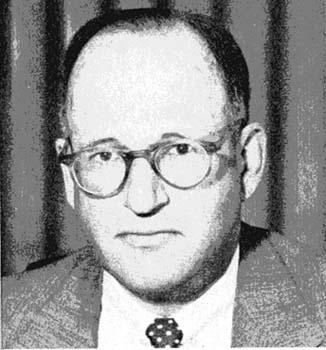 Palo Alto Stanford Heritage
Palo Alto Stanford Heritage 
The end of World War II brought tremendous change to the Mid–Peninsula. New residents with G.I. housing and education loans sought work and study opportunities at Stanford and at the nascent electronics industries; others came simply for the mild weather and cheap land. This influx, combined with a dearth of residential construction since the 30s, led to a construction boom. Cookie cutter suburban developments proliferated, built on spec by “merchant builders.” From 1946 to 1949, before he became famous for bringing affordable modernist design to the masses, Joseph Eichler was a successful merchant builder constructing over 300 conventional houses. He bought his first set of plans for $25 from “Flat Top” Miller, a prolific pre–fab developer in Oakland. What caused his transformation from ordinary to iconic?
Eichler was born in New York City in 1900 to European Jewish immigrant parents of modest means and liberal politics. A life–long Democrat, he grew to maturity in culturally diverse New York City. After receiving a business degree from N.Y.U. in 1920, he worked for Wall Street investment firms. In 1925, Joe wed Lillian, whose parents, also Jewish immigrants, ran a successful wholesale butter and egg business. Joe worked for the family business and soon relocated to its San Francisco branch with his wife and two children, Robert and Ned. According to Ned, Eichler found the job uninspiring, but his competitiveness and determination served him well, and, ultimately, he became treasurer. The family lived in traditional housing until 1942, when Joe excitedly announced that they were moving to a Hillsborough rental designed by Frank Lloyd Wright. This contemporary “Usonian” house, with its open floor plan, so enthralled Eichler that he and Lillian hired a young Wright disciple, Robert Anshen, to design a contemporary house for them—a project that wouldn’t come to fruition for a decade. By 1945, the Wright house lease expired, as did Joe’s job when the family business folded.
Searching for a second career, Eichler, who had never used a hammer, purchased two sets of plans from “Flat Top” Miller, the Oakland developer. Between 1946 and 1949, he boldly transformed himself into the aforementioned “merchant-builder.” When the architect, Robert Anshen, visited one of Eichler’s job sites and asked “How can someone like you, who loves real architecture, build this crap?” Eichler was annoyed and intrigued. Developers, at this time, regarded architects as an unnecessary expense, yet the adventurous Eichler agreed to let Anshen create three plans for $2,500. The result was a 50–unit subdivision called Sunnyvale Manor 11. Completed in February 1950, it sold out in two weeks. It also won national acclaim for its radical design: exposed post–and–beam construction on concrete slab foundations with radiant heating, flat roofs, windowless horizontal façades; floor–to–ceiling windows and sliding glass doors opening to the rear garden, exposed ceiling beams; tongue and groove redwood ceilings following the roof-line; lauan paneling and an open floor plan.
Eichler and Anshen’s partnership expanded the architectural lexicon to include “Eichler” and “California Modern.” Because this radical style appealed to a small segment of sophisticated but non–moneyed buyers, it required equally radical merchandising methods. Eichler refined production methods to keep prices down; he assembled an aggressive marketing team; he pioneered the concept that modern architecture could create a better way of life for the average family. Eichler referred to his vision as “The American Way” and we can see it in two of his Palo Alto subdivisions—Fairmeadows and Greenmeadow. Both are located south of Oregon Avenue, where Eichler built 3,000 houses out of a total of 11,000 throughout California. Fairmeadows, built in the early 50’s and designed by Anshen, was named “Subdivision of the Year” by Architectural Forum. Most of the houses have flat roofs or a low–pitched gable with clerestory windows, but Fairmeadows’ distinctive feature is the street layout formed from three distinct concentric circles. The circular street pattern avoids the monotony of the typical suburban grid, but its primary purpose is to foster neighborhood cohesiveness, safe streets and a vibrant community.
Eichler worked with a stable of architects including Quincy Jones and Claude Oakland. Jones designed Joe’s favorite subdivision in 1955, the 243–house Greenmeadow tract. This National Register neighborhood has a central recreation area with park and swimming pool plus a childcare facility. Several main streets with many cul–de–sacs branching off foster privacy, street play and a family–friendly atmosphere. Gaining approval from the Palo Alto City Council for this project encountered resistance, as the public spaces necessitated sub–standard sized lots for the houses. The greatest obstacle, however, was created when Eichler called the council members disparaging names because they questioned the superior benefits of his project. Cooler heads won the day and Joe promised never again to appear before a city council.
Eichler’s career continued several decades until his death in 1974, but that story will have to wait until the next installment. ©
(See Part 2: Joe Eichler and His Houses 1955–1974)
PAST, November 1 and November 8, 2013
E-mail us at either webmaster@pastheritage.org or president@pastheritage.org.
![]() Palo Alto Stanford Heritage—Dedicated to the preservation of Palo Alto's historic buildings.
Palo Alto Stanford Heritage—Dedicated to the preservation of Palo Alto's historic buildings.
Copyright © 2012 Palo Alto Stanford Heritage. All rights reserved.